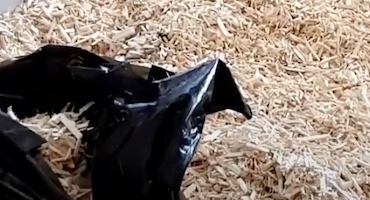Owning a hamster is a fun and rewarding experience, but these tiny pets can deliver a painful bite that can make you wonder what you did wrong. There are a few reasons why hamsters bite, but the most common is improper taming.
If you’re having problems with a biting hamster and aren’t sure how to stop it, don’t lose hope. Even the fiercest of hamsters can be tamed to stop viewing their owners as chew toys with these simple steps.
Why Do Hamsters Bite?
In the wild, hamsters are easy prey for a lot of predators due to their small size. To help defend themselves, hamsters will bite when they feel threatened or nervous. Untamed hamsters cannot distinguish between you and something that is trying to harm them.
This can lead to them nipping or biting you. Hamsters who bite rarely do it aggressively, as they would much rather flee than lash out. When pet hamsters nip, it’s normally because they are frightened or anxious.
If your hamster has never been handled before or is not used to human interaction, then a giant hand swooping in to pick them up can be startling. If your hamster has no way of escape, their only response may be to bite. Despite their tiny appearance, a hamster bite can be very painful, so it’s definitely something you want to try to avoid if you can.
However, if your hamster is already tame and has recently started biting you, then it could be due to an injury or illness. Hamsters who are in pain may nip, especially if you touch a tender area. If you suspect your hamster is unwell, take them to a vet as soon as possible.
Another reason why hamsters bite is being woken up abruptly. It’s best to wait until your hamster is naturally awake before interacting with them so you don’t startle them. If you do need to wake your hamster up, then gently call their name or lightly rustle their bedding to gradually bring them out of their slumber.
How to Stop Hamsters from Biting You (and Make Friends in 30 days)
Taming your hamster might seem like a long and complicated route, but it’s a lot simpler than you think. A way to any hamster’s heart is food, so use this to your advantage. Following these simple steps below will help stop your hamster from biting and make them view you as a friend, not a foe.
Day 1-5
When you first bring your hamster home, it’s tempting to start handling them straight away. However, you should allow your hamster some time to settle into their new home without any disturbances.
Leave your hamster completely alone for a few days to help them feel more at ease in their new habitat.
Day 5-10
Once you have given your hamster some time to relax, you can start the taming process.
Start off slow by talking to your hamster through the cage bars when they are up and about. Use a soft and gentle voice so you don’t scare your pet. After doing this for a few days, your hamster should begin to feel more comfortable with your presence.
Day 15-20
You can now start to offer your hamster some treats. Either feed your hamster through the cage bars or via the door. To begin with, your hamster may take the treat and run off to hide with it. This is completely normal, but with time your hamster should start to linger for longer once they feel safer.
When your hamster starts to take the treat without fleeing, you can start placing your hand into their cage. It’s a good idea to rub some of your hamster’s bedding over your hands to help transfer their scent to you.
Let your hamster approach your hand to explore it. Don’t try to stroke your hamster at this point, just allow them to sniff and investigate your hand.
Day 20-25
Once your hamster is beginning to get used to you, place a treat onto your open hand. At first, they may ignore the treat or take it and run off. Eventually, however, your hamster should feel relaxed enough to climb onto your hand and stay there while they eat the treat.
When your hamster is confidently taking the treat from your hand without running away, you can try to touch them. Gently stroke your hamster’s body with your finger. Avoid touching their head or belly as they are delicate areas. Watch your hamster’s reaction. If they slink down, bare their teeth, screech, or start raising their paws, then back away. Your hamster might not be ready to move forward just yet.
If, however, your hamster seems unbothered by your touch, then that’s a good sign and shows that you’re winning their trust.
Day 25-20
Now that you’ve almost befriended your hamster, you can start trying to hold them. Use both your hands to scoop them up. Your hamster might try to jump out your hands initially, so make sure you hold them close to the ground.
When holding your hamster, keep your hands cupped around them. It’s best to hold your hamster sitting down and close to your chest. At first, you may only be able to hold your hamster for a couple of minutes before they’ve had enough. But with regular taming sessions, your hamster should begin to feel more comfortable being held for longer.
How to Prevent Hamsters from Biting You Again?
To prevent your hamster from biting you, always go at their own pace when you trying to tame them. Going too fast during taming sessions can shake your hamster’s confidence in you and make them more likely to bite. Be patient and always make sure your hamster is ready before you attempt later steps in training.
When you are handling or taming your hamster, wash your hands thoroughly with unscented soap. Your hamster may try to nip you if your hands smell like food or something they find interesting.
Avoid interacting with your hamster during the day or when they are sleeping. Hamsters can be grumpy when they have been woken up abruptly, so it’s a good idea to wait until they are already awake before you try taming or holding them.
Always be calm and collected around your hamster. Use slow movements and a gentle voice to avoid scaring your hamster. If your hamster does bite you, try not to panic or scream as this will make matters worse.
What to Do If My Hamster Bites Me?
If your hamster bites you, it can be very painful, especially if they have broken the skin. The worst thing you can do is yell or jolt around, as this could frighten your hamster and result in them biting you again.
Calmly put your hamster back in their cage and try interacting with them again another day. Run your bite under running water to help flush out any bacteria. You might want to use an antibacterial wipe too. If your hamster has drawn blood, then use a plaster to help stop the bleeding.
Although painful, hamster bites aren’t usually serious. If you begin feeling unwell or think your bite has become infected, then seek medical attention.
Don’t feel too disheartened if your hamster bites you. If they nipped you during a taming session, then consider repeating earlier steps as you may have moved a bit too fast.
Final Thoughts – How to make my hamster stop biting me
Remember, when hamsters bite, it’s not because they’re being mean. It’s usually due to fear, injury/illness, or stress. Unsocialized hamsters can and will nip if they feel threatened, so your best bet is to follow a taming method to help prevent being bitten.
The taming method above is a common technique used by hamster owners, so it should help you and your pet become the best of friends in no time.
Share
Related Posts
Hamsters are social creatures who value companionship. But introducing hamsters to one another may be a tricky task [...]




